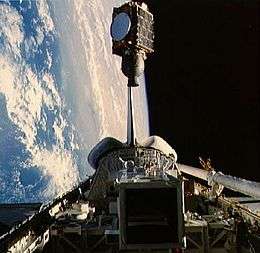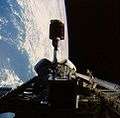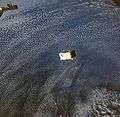STS-51-G
 Discovery deploys Morelos 1 | |||||
| Mission type | Satellite deployment | ||||
|---|---|---|---|---|---|
| Operator | NASA | ||||
| COSPAR ID | 1985-048A | ||||
| SATCAT № | 15823 | ||||
| Mission duration | 7 days, 1 hour, 38 minutes, 52 seconds | ||||
| Distance travelled | 4,693,051 kilometres (2,916,127 mi) | ||||
| Orbits completed | 112 | ||||
| Spacecraft properties | |||||
| Spacecraft | Space Shuttle Discovery | ||||
| Launch mass | 116,357 kilograms (256,524 lb) | ||||
| Landing mass | 92,610 kilograms (204,169 lb) | ||||
| Payload mass | 17,280 kilograms (38,096 lb) | ||||
| Crew | |||||
| Crew size | 7 | ||||
| Members |
Daniel C. Brandenstein John O. Creighton John M. Fabian Steven R. Nagel Shannon W. Lucid Patrick Baudry Sultan Salman Al Saud | ||||
| Start of mission | |||||
| Launch date | June 17, 1985, 11:33:00 UTC | ||||
| Launch site | Kennedy LC-39A | ||||
| End of mission | |||||
| Landing date | June 24, 1985, 13:11:52 UTC | ||||
| Landing site | Edwards Runway 23 | ||||
| Orbital parameters | |||||
| Reference system | Geocentric | ||||
| Regime | Low Earth | ||||
| Perigee | 353.3 kilometres (219.5 mi) | ||||
| Apogee | 354.9 kilometres (220.5 mi) | ||||
| Inclination | 28.45 degrees | ||||
| Period | 91.8 minutes | ||||
| Epoch | June 19, 1985[1] | ||||
  Back L-R: Lucid, Nagel, Fabian, Al-Saud, Baudry, Front L-R: Brandenstein, Creighton
| |||||
STS-51-G was the eighteenth flight of NASA's Space Shuttle program, and the fifth flight of Space Shuttle Discovery. The seven-day mission launched from Kennedy Space Center, Florida, on June 17, 1985, and landed at Edwards Air Force Base, California, on June 24. Sultan Salman Al Saud of Saudi Arabia was on board as a payload specialist; Al Saud became the first Arab, the first Muslim, and the first member of a royal family to fly into space.[2] It was also the first Space Shuttle mission which flew without at least one astronaut from the pre-Shuttle era among its crew.
Crew
| Position | Astronaut | |
|---|---|---|
| Commander | Second spaceflight | |
| Pilot | First spaceflight | |
| Mission Specialist 1 | Second spaceflight | |
| Mission Specialist 2 | First spaceflight | |
| Mission Specialist 3 | First spaceflight | |
| Payload Specialist 1 | Only spaceflight | |
| Payload Specialist 2 | Only spaceflight | |
| Al Saud became the first member of royalty to fly into space, as well as the first Arab and the first Muslim. | ||
Backup crew
| Position | Astronaut | |
|---|---|---|
| Payload Specialist 1 | Second spaceflight | |
| Payload Specialist 2 | First spaceflight | |
Crew seating arrangements
| Seat[3] | Launch | Landing |  Seats 1–4 are on the Flight Deck. Seats 5–7 are on the Middeck. |
|---|---|---|---|
| S1 | Brandenstein | Brandenstein | |
| S2 | Creighton | Creighton | |
| S3 | Fabian | Lucid | |
| S4 | Nagel | Nagel | |
| S5 | Lucid | Fabian | |
| S6 | Baudry | Baudry | |
| S7 | Al Saud | Al Saud | |
Mission summary
Discovery lifted off from Pad A, Launch Complex 39, Kennedy Space Center (KSC), at 7:33 am EDT on June 17, 1985. The mission's crew members included Daniel C. Brandenstein, commander; John O. Creighton, pilot; Shannon W. Lucid, Steven R. Nagel, and John M. Fabian, mission specialists; and Patrick Baudry, of France, and Prince Sultan Salman Al Saud, of Saudi Arabia, both payload specialists.
STS-51-G carried three communications satellites as its primary cargo. These were Arabsat-1B (Arab Satellite Communications Organization); Morelos I (Mexico); and Telstar 3D (AT&T Corporation). All three successfully utilized PAM-D booster stages to achieve geosynchronous transfer orbits after being deployed from Discovery.
Also carried was the Spartan 1 carrier module, designed to be deployed from the orbiter and fly free in space before being retrieved. Spartan 1 included 140 kilograms (300 lb) of astronomy experiments. It was deployed and operated successfully, independent of the orbiter, before being retrieved. Discovery furthermore carried an experimental materials-processing furnace, several French biomedical experiments, and six Getaway Special experiments, which were all successfully performed, although the GO34 Getaway Special shut down prematurely.
The mission's final payload element was a High Precision Tracking Experiment (HPTE) for the Strategic Defense Initiative (nicknamed "Star Wars"); the HPTE failed to deploy properly during its first try on the mission's 37th orbit, because the orbiter was not at the correct attitude. It was successfully deployed on orbit 64.
Discovery landed at Edwards Air Force Base at 9:12 am EDT on June 24, 1985, after a mission duration of 7 days, one hour, 38 minutes and 52 seconds.
Wake-up calls
NASA began a tradition of playing music to astronauts during the Gemini program, and first used music to wake up a flight crew during Apollo 15. Each track is specially chosen, often by the astronauts' families, and usually has a special meaning to an individual member of the crew, or is applicable to their daily activities.[4]
| Flight Day | Song | Artist/Composer |
|---|---|---|
| Day 2 | "I Feel the Earth Move" | Carole King |
| Day 3 | "Proud Mary" | Creedence Clearwater Revival |
| Day 4 | "Sailing" | Christopher Cross |
| Day 5 | "Jonathan Livingston Seagull" | Neil Diamond |
| Day 6 | "Wedding March" | Felix Mendelssohn |
Gallery
 Arabsat-1B deployment
Arabsat-1B deployment Morelos I deployment
Morelos I deployment Telstar 3D deployment
Telstar 3D deployment Spartan 1 after deployment
Spartan 1 after deployment
See also
References
![]() This article incorporates public domain material from websites or documents of the National Aeronautics and Space Administration.
This article incorporates public domain material from websites or documents of the National Aeronautics and Space Administration.
- ↑ McDowell, Jonathan. "SATCAT". Jonathan's Space Pages. Retrieved March 24, 2014.
- ↑ "A prince in space" at Saudi Aramco World. January/February 1986 edition. p.20–29. Retrieved October 23, 2012.
- ↑ "STS-51G". Spacefacts. Retrieved February 26, 2014.
- ↑ Fries, Colin (June 25, 2007). "Chronology of Wakeup Calls" (PDF). NASA. Retrieved August 13, 2007.
